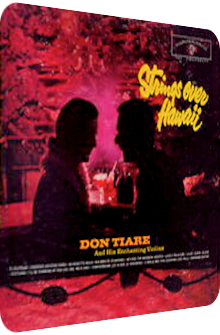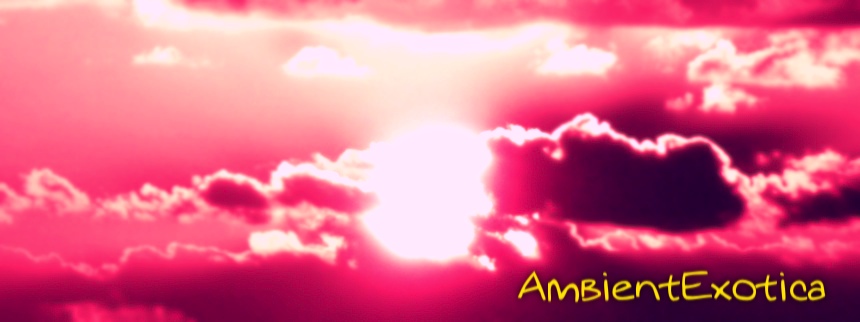
Don Tiare
Strings Over Hawaii
1963
If I did not know better – or actually: know worse –, chances are that I would declare the persona of Don Tiare a spectral apparition, a figment of the mind, a mirage from the desert. A tiare is a Tahitian Gardenia that grows in Melanesia and Polynesia, so the exotic factor of this stage name is carefully chosen. However, next to nothing is known about this arranger of string-heavy works, or to put it differently, I would go so far as to state that vibraphonist Gene Rains is a world-famous superstar in comparison to Don Tiare. So whoever this mystical person is, whether Don Tiare is a pseudonym or not, he knows how to set up an orchestra. And he proves it on a surprising amount of albums, Don Tiare is no one-trick pony, has more LP's in his discography than one Mr. Rains and even comes up with his own compositions from time to time. He is probably best known (at least comparably so) for his 1963 album The Music Of Les Baxter for which Baxter himself wrote a few unique tracks. The liner notes of that work describe the arranger as follows: "Don Tiare is an international performer whose expressive combo is as familiar in Bangkok as in Bourdeaux, as comfortable in Nikko as in Nice […]" and so on. Damn you, marketing hogwash! No utilizable information at all.
In this review, I am focusing on Don Tiare's work Strings Over Hawaii which he recorded with His Enchanting Violins, although flutes, reeds, mallet instruments and a piano are on board as well. Strings Over Hawaii also has a foil or twin called Strings Over Tahiti. Both albums are released in 1961 on Warner Brothers. I know that Strings Over Hawaii is available in two editions, one with a purple-magenta romantic motive as depicted above, and another one with a charted bird's eye perspective over Hawaii. Both artworks fit perfectly, the purple one matches the intrinsic color range, the charted one is congruent with the title. A potpourri of 12 tracks is presented, comprising of well-known Hapa Haole material, lost treasures and one unique composition written by Don Tiare himself.
The variety of the material makes Strings Over Hawaii slightly more interesting than like-minded LP's, but that is up for debate. Undebatable meanwhile is the enormous saturation of the arrangements. The glaring colors of the Hollywood strings augment the enthralling aspects, the complete omission of steel guitars and ukuleles is perhaps alienating, but works to the album's advantage, for these instruments are heard on millions of Hawaiian albums anyway. I call their utter neglection a nice change for once. A tad heftier is the complete silence of any exotic percussion instrument. There are zilch, none. No shakers, no drums, nothing. Yet Strings Over Hawaii works really well and is a splendid jewel with some additional inanities which are carved out below. Rest assured, though, that there are enough glamorous takes on there to doubt the forgotten status of Don Tiare even more.
Admittedly, the opener Blue Hawaii is not the best choice if one wanted to convince Exotica listeners about the wonderful arrangements of Don Tiare, but this is the way it is. Originally concocted by Leo Robin and Ralph Rainger, Blue Hawaii is one of the most-often covered pieces of Hawaiiana out there. It is decidedly smooth and syrupy, but also comprises of a strong chintziness that is baked into the melody itself. Don Tiare offers a faithful rendition of the songwriting duo's original version, the strings whirr along in higher regions, lachrymosity and grandeur float into the melody and are ennobled by effervescent flute tittles. This is your bog standard interpretation that cannot make a dent against the competition.
Dick Manning's I'll Be Thinking About You improves the situation, and strongly so. Nothing much has changed, the same strings and flutes are on board, but here the lead fiddle wafts in front of glistening triangle spirals and glockenspiel flecks, the genteel flutes either jump carefully around the double bass-backed rhythm or reside in legato lands, working well in tandem with the phantasmagoric undulation of the strings. Being another kitschy song, the colors and tonal ranges of the strings is much improved, more auroral and rose-tinted, so much so that I may recognize the cheesiness, but am hopelessly lured by the thickness of the strings.
Up next is Jack Pitman's Lovely Hula Girl, an absolutely stunning piece. The strings are of the Space-Age kind, completely out of this world and way above the clouds. The glockenspiels and alto flutes add little accents to the wall of strings, but their euphony cannot outshine the pink luminosity of the orchestra, not even when the strings whirl in the distance in the latter half of the tune, a tune charged with romance which manages to remain tasteful. Whereas Dick Manning's and Irmgard Fardon Aluli's Sea Breeze is a sunny ditty of hukilaus in the sunshine with all too saccharine strings, mildly annoying effervescent clarinets and actually successful aural visualizations of the glinting sunlight on the waves by the means of glockenspiels, Fardon Aluli's second tune Hawaiian Love Call (also known as E Maliu Mai) sees the strings and glockenspiels back in full force, but to not much avail since the majestic pompousness is adamantly lessened by schmaltzy melodies. Only a short downwards spiraling segue which features strangely warped Space-Age traces can be deemed truly great, with the following flute solo adding dots of jungular greatness as well, though the rest remains a blur.
Hawaiian Guitar rounds off side A, which is actually the Hawaiian Guitar Waltz by Charles E. King. The pool of instruments is widened for the first time. An easygoing piano is woven into the mellow scenery full of flutes, clarinets, glockenspiels strings and two-note double bass drops. Shuttling between strings of honey and paradisiac reed sections, Hawaiian Guitar is a hybrid that meshes the sumptuous bliss of Lovely Hula Girl with the insipid romance of Mrs. Fardon Aluli's material.
So side A has been a hit-or-miss affair. Side B hits and hits and hits. Charles E. King's, Dick Manning's and Al Hoffman's Hawaiian Wedding Song has been interpreted thousands of times, but Don Tiare's version somehow manages to let the sweetness appear splendid. Quieter scenes follow fully charged string segues and pizzicato flutes, business as usual, and yet something is different, as the use of vibraphones (that gorgeous glissando apotheosis!) aptly shows. The luminosity and brightness as well as the solemnity make this a great piece once Don Tiare is part of the game.
Lani Muk Sang's Mapuana is next. Famous for its inclusion on Arthur lyman's superdreamy Hawaiian Sunset (1959), Don Tiare's take succeeds on a different, namely symphonic level, kicks off the wraithlike panorama with blossoming flutes and then unleashes awe-inspiring violins, violas, cellos, you name it. The additional flute aorta and the glockenspiel phase only expand the dream. The strings' tone sequences are positively flamboyant yet graceful, the success of the lead fiddle's part is a bit weaker but by no means misplaced, and the final ending of a music box-fueled lullaby is splendid. There is no mistake: Mapuana is one of the best Hawaiian pieces out there, not often considered, thus all the more luring once it appears. Mesmerizing.
Charles E. King teamed up with Milt Raskin once, and the result is the better known Forevermore. Since Don Tiare arranged Mapuana in a fairy tale-evoking way, Forevermore remains in these stylistic climes. A prelude comprising of a lone fiddle and an aqueous music box leads to string serpentines and cascading reeds. The atmosphere is coated in a positive and comfortable twilight, the pizzicato strings are delicately diffuse in contrast to the twinkling vibes. A tad more dreamy than corny, Forevermore is a wonderful piece. Léon Pober's Beyond The Rainbow follows and works best when the listener submerges into languorous structures of ethereal strings and tends to be less successful when the fragile flutes and clarinets play before a thin background. Warmth and coziness completely vanish in these instances. This one is a rare dud, so: next hit please.
Danny Kalauawa Stewart's and Steve Graham's Silhouette Hula unites all the wondrous elements of this album, and now everything works out strikingly: whitewashed music box droplets with jazzy scents, polyphonous legato flutes and a finale where the strings are played in even lusher ways, Silhouette Hula feels like a blur, a carefree dream quite similar to the equally moony Lovely Hula Girl. Don Tiare is at his best here. Alas, the curtain calls, but not before the treat of all treats – in the given context of this LP at least – is delivered in the shape of Don Tiare's quasi-unique composition called Lilue-Leahi-Aloha, and thank the tiki gods that it is a balmy piece of greatness. The catchiness of the melodies is not the important marker here rather than the wealth of the textures, the glow of the strings, the plinking moisture of the glockenspiels and the pizzicato sections with deep bass blebs. As the final part of the track title already reveals, Lulue-Leahi flows into the ultimate nexus of the Hawaiian helix called Aloha Oe. The flood of strings ennobles the world-famous four-note chorus and lets it transcend into something far greater than truthful ukulele-based Hapa Haole records could possibly offer. A great closure!
The more I think about it, the better I like the album title. Strings Over Hawaii is a wonderful condition in and on its own, but it really matches the presented soundscape. Don Tiare has crafted an album – one of many – that is largely forgotten, but the shimmering incandescence gleams its way through the 21st century, albeit on a low, calcined flame. True, the 101 Strings have hit home-runs with their string-charged albums Hawaiian Paradise (1961) and The Romance Of Hawaii (1969) which offer field recordings, a larger variety of instruments plus ukulele chords, but Don Tiare's effort turns into a wonderfully poeticized and lofty work. The title gives it away: the roots of the strings are not touching Hawaiian soil, no, they tower above the islands. Although there are questionable amounts of pesky sugar-coated timbres, Don Tiare's superimposition of strings, reeds, chimes and mallet instruments works really well despite the omission of exotic percussion.
Songs like Lovely Hula Girl, Silhouette Hula and Mapuana maintain the depicted candlelight romance on the purple version of this album, but advect huge amounts of enchanting melodies to the arrangements. When the textures of the strings meet the right timbre, Strings Over Hawaii bursts at the seams, flashes in technicolor and blazes without any compromise. I have noticed a certain tendency: this album – and its foil Strings Over Tahiti – is least enchanting and luring when the strings wind down and make room for the other instruments. This is not a problem per se, symphonic pieces cannot remain in the state of crescendo all the time, but the warmth, the shelter, the capsule of rapture vanish quickly when the gleeful pizzicato strings get entangled with the flutes; thinness and reduction unfold.
At its core, Strings Over Hawaii is an album of romance, love and devotion and much less about sunshine, beaches or luaus, so be aware of this overarching topic and all its implied tonalities and structures. Fans of Jackie Gleason and Nelson Riddle should investigate, at the time of writing this review, preferably via eBay or GEMM, as there is only one album of Don Tiare that has been re-issued at all: The Music Of Les Baxter from 1963, undoubtedly due to the fact that the maestro himself was involved during the production.
Exotica Review 209: Don Tiare – Strings Over Hawaii (1963). Originally published on Apr. 27, 2013 at AmbientExotica.com.
